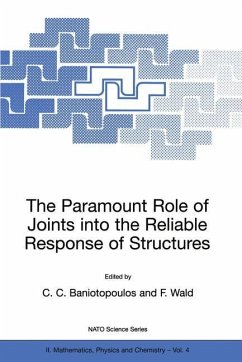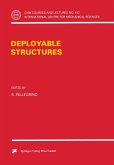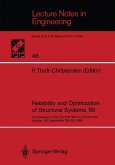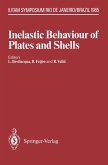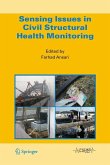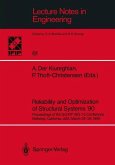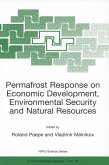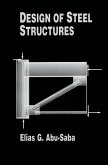BaniotopoulosFrom the Classic Pinned and Rigid Joints to the Notion of Semi-rigidity
The Paramount Role of Joints into the Reliable Response of Structures
From the Classic Pinned and Rigid Joints to the Notion of Semi-rigidity
Herausgegeben von Baniotopoulos, C. C.; Wald, F.
BaniotopoulosFrom the Classic Pinned and Rigid Joints to the Notion of Semi-rigidity
The Paramount Role of Joints into the Reliable Response of Structures
From the Classic Pinned and Rigid Joints to the Notion of Semi-rigidity
Herausgegeben von Baniotopoulos, C. C.; Wald, F.
- Broschiertes Buch
- Merkliste
- Auf die Merkliste
- Bewerten Bewerten
- Teilen
- Produkt teilen
- Produkterinnerung
- Produkterinnerung
A detailed presentation of the major role played by correctly designed and fabricated joints in the safe and reliable response of steel, composite and timber structures. The typology/morphology of connections is discussed for both conventional pinned and rigid joints and semi-rigid types. All relevant topics are comprehensively surveyed: definitions, classification, and influence of joint behaviour on overall structural response. Also presented are the application of the component method, the notion of rotational capacity, the local ductility of different types of earthquake-resistant…mehr
Andere Kunden interessierten sich auch für
![Deployable Structures Deployable Structures]() S. Pellegrino (ed.)Deployable Structures149,99 €
S. Pellegrino (ed.)Deployable Structures149,99 €![Reliability and Optimization of Structural Systems '88 Reliability and Optimization of Structural Systems '88]() Reliability and Optimization of Structural Systems '8877,99 €
Reliability and Optimization of Structural Systems '8877,99 €![Inelastic Behaviour of Plates and Shells Inelastic Behaviour of Plates and Shells]() Inelastic Behaviour of Plates and Shells116,99 €
Inelastic Behaviour of Plates and Shells116,99 €![Sensing Issues in Civil Structural Health Monitoring Sensing Issues in Civil Structural Health Monitoring]() Sensing Issues in Civil Structural Health Monitoring149,99 €
Sensing Issues in Civil Structural Health Monitoring149,99 €![Reliability and Optimization of Structural Systems '90 Reliability and Optimization of Structural Systems '90]() Reliability and Optimization of Structural Systems '90115,99 €
Reliability and Optimization of Structural Systems '90115,99 €![Permafrost Response on Economic Development, Environmental Security and Natural Resources Permafrost Response on Economic Development, Environmental Security and Natural Resources]() PaepePermafrost Response on Economic Development, Environmental Security and Natural Resources318,99 €
PaepePermafrost Response on Economic Development, Environmental Security and Natural Resources318,99 €![Design of Steel Structures Design of Steel Structures]() Elias G. Abu-SabaDesign of Steel Structures176,99 €
Elias G. Abu-SabaDesign of Steel Structures176,99 €-
-
-
A detailed presentation of the major role played by correctly designed and fabricated joints in the safe and reliable response of steel, composite and timber structures. The typology/morphology of connections is discussed for both conventional pinned and rigid joints and semi-rigid types. All relevant topics are comprehensively surveyed: definitions, classification, and influence of joint behaviour on overall structural response. Also presented are the application of the component method, the notion of rotational capacity, the local ductility of different types of earthquake-resistant structural joints as determined in cyclic experiments, numerical techniques for the realistic simulation of joint response, simple and moment-resistant structural connections.
Readership: An incomparable resource for engineers who analyze and design steel, composite and timber structures; researchers and graduate students in the same areas.
Readership: An incomparable resource for engineers who analyze and design steel, composite and timber structures; researchers and graduate students in the same areas.
Produktdetails
- Produktdetails
- NATO Science Series II Mathematics, Physics and Chemistry 4
- Verlag: Springer / Springer Netherlands / Springer, Berlin
- Artikelnr. des Verlages: 978-0-7923-6701-7
- 2000.
- Seitenzahl: 468
- Erscheinungstermin: 31. Dezember 2000
- Englisch
- Abmessung: 240mm x 160mm x 26mm
- Gewicht: 740g
- ISBN-13: 9780792367017
- ISBN-10: 0792367014
- Artikelnr.: 27615412
- Herstellerkennzeichnung
- Springer-Verlag GmbH
- Tiergartenstr. 17
- 69121 Heidelberg
- ProductSafety@springernature.com
- NATO Science Series II Mathematics, Physics and Chemistry 4
- Verlag: Springer / Springer Netherlands / Springer, Berlin
- Artikelnr. des Verlages: 978-0-7923-6701-7
- 2000.
- Seitenzahl: 468
- Erscheinungstermin: 31. Dezember 2000
- Englisch
- Abmessung: 240mm x 160mm x 26mm
- Gewicht: 740g
- ISBN-13: 9780792367017
- ISBN-10: 0792367014
- Artikelnr.: 27615412
- Herstellerkennzeichnung
- Springer-Verlag GmbH
- Tiergartenstr. 17
- 69121 Heidelberg
- ProductSafety@springernature.com
List of Contents.- 1.1 Effects of the Actual Joint Behaviour on the Design of Steel Frames.- 1.2 Behavior and Design of Partially-Restrained Composite Framing Systems.- 1.3 Prediction of Ultimate Load of Steel Frames with Semi-rigid Connections.- 1.4 Effective Length Factor Considering Semi-rigid Connections.- 1.5 Practical Demonstration of the Use of Joint Flexibility in Steel Frame Design.- 1.6 Development, Design and Testing of Joints in Composite Structures.- 1.7 Application of the Theory of Semi-rigid Joints into Steel and Composite Structures.- 1.8 Wind Effects on Large Antennas and Telecommunication Towers: Analysis and Design of Main Components and Joints.- 2.1 Application of Deformation Criteria in Bolted Connection Strength Design.- 2.2 Large-scale Experimental Tests on Steel and Composite Frames.- 2.3 Cyclic Tests on Bolted Steel Double-Sided Beam-to -Column Joints.- 2.4 Experimental Investigation of Load Carrying Capacity of the Joints into an Aluminium Dome.- 2.5 Experimental and Analytical Studies on the Cyclic Behaviour of Column-Base Joints.- 2.6 Bolted Joints in Thin Walled Cross-sections of Type Z Made from Cold Formed Steei.- 2.7 Review and Classification of Semi-rigid Connections.- 3.1 Behaviour of Connections of Seismic Resistant Steel Frames.- 3.2 Observed Beam Column Joint Failures During the 17 August 1999-Kocaeli and 12 November 1999-Duzce, Turkey Earthquakes.- 3.3 Influence of Semi-rigid and/or Partial-strength Joints on the Seismic Performances of Steel MRF.- 3.4 Cyclic Behaviour of End-Plate Beam-to-Column Composite Joints.- 3.5 A Nonconvex Optimization Approach for the Determination of the Capacity Curve and the Performance Point of MR Steel Frames Exhibiting Softening under Seismic Loading.- 3.6 Bi-directional Pseudodynamic Test of a Full-size Three Storey Steel Concrete Building with Rigid and Semi-rigid Joints.- 3.7 Influence of Joint Flexibility in the Seismic Performance of Moment Resisting Steel Frames.- 3.8 Dynamic Analysis of Stiffened Coupled Shear Walls with Flexible Connections under Earthquake Effects.- 4.1 Numerical Modelling of the Structural Behaviour of Joints.- 4.2 Cyclic Analysis of Structural Joints by Computational Models.- 4.3 A Contribution to the Finite Element Study of Pin Connections in Steel Structures.- 4.4 Recent Advances in the Numerical Modelling of the Response of Structural Steelwork Taking into Account Softening in Connection Behaviour.- 4.5 Finite Element Analyses of Steel-Concrete Subassemblage with Partial Shear Connection.- 4.6 Butt-Welded Aluminium Joints: a Numerical Study of the HAZ Effect on the Ultimate Tension Strength.- 5.1 Designing Structural Joints according to Eurocodes.- 5.2 Rotation Capacity of Steel Joints: Verification Procedure and Component Tests.- 5.3 Review of Deformation Capacity of Joints Related to Structural Reliability.- 5.4 Modelling of Joints of Sandwiches Panels.- 5.5 New Design Concepts for Structural Timber Connections.- 5.6 Timber Joints Loaded Perpendicular to the Grain: Long-term Strength, Theory and Experiments.- 5.7 Component Method for Historical Timber Joints.- 5.8 Application of the Component Method to Steel Joints under Fire Loading.- 5.9 Stiffness of Lap Joints with Preloaded Bolts.- Authors Index.
List of Contents.- 1.1 Effects of the Actual Joint Behaviour on the Design of Steel Frames.- 1.2 Behavior and Design of Partially-Restrained Composite Framing Systems.- 1.3 Prediction of Ultimate Load of Steel Frames with Semi-rigid Connections.- 1.4 Effective Length Factor Considering Semi-rigid Connections.- 1.5 Practical Demonstration of the Use of Joint Flexibility in Steel Frame Design.- 1.6 Development, Design and Testing of Joints in Composite Structures.- 1.7 Application of the Theory of Semi-rigid Joints into Steel and Composite Structures.- 1.8 Wind Effects on Large Antennas and Telecommunication Towers: Analysis and Design of Main Components and Joints.- 2.1 Application of Deformation Criteria in Bolted Connection Strength Design.- 2.2 Large-scale Experimental Tests on Steel and Composite Frames.- 2.3 Cyclic Tests on Bolted Steel Double-Sided Beam-to -Column Joints.- 2.4 Experimental Investigation of Load Carrying Capacity of the Joints into an Aluminium Dome.- 2.5 Experimental and Analytical Studies on the Cyclic Behaviour of Column-Base Joints.- 2.6 Bolted Joints in Thin Walled Cross-sections of Type Z Made from Cold Formed Steei.- 2.7 Review and Classification of Semi-rigid Connections.- 3.1 Behaviour of Connections of Seismic Resistant Steel Frames.- 3.2 Observed Beam Column Joint Failures During the 17 August 1999-Kocaeli and 12 November 1999-Duzce, Turkey Earthquakes.- 3.3 Influence of Semi-rigid and/or Partial-strength Joints on the Seismic Performances of Steel MRF.- 3.4 Cyclic Behaviour of End-Plate Beam-to-Column Composite Joints.- 3.5 A Nonconvex Optimization Approach for the Determination of the Capacity Curve and the Performance Point of MR Steel Frames Exhibiting Softening under Seismic Loading.- 3.6 Bi-directional Pseudodynamic Test of a Full-size Three Storey Steel Concrete Building with Rigid and Semi-rigid Joints.- 3.7 Influence of Joint Flexibility in the Seismic Performance of Moment Resisting Steel Frames.- 3.8 Dynamic Analysis of Stiffened Coupled Shear Walls with Flexible Connections under Earthquake Effects.- 4.1 Numerical Modelling of the Structural Behaviour of Joints.- 4.2 Cyclic Analysis of Structural Joints by Computational Models.- 4.3 A Contribution to the Finite Element Study of Pin Connections in Steel Structures.- 4.4 Recent Advances in the Numerical Modelling of the Response of Structural Steelwork Taking into Account Softening in Connection Behaviour.- 4.5 Finite Element Analyses of Steel-Concrete Subassemblage with Partial Shear Connection.- 4.6 Butt-Welded Aluminium Joints: a Numerical Study of the HAZ Effect on the Ultimate Tension Strength.- 5.1 Designing Structural Joints according to Eurocodes.- 5.2 Rotation Capacity of Steel Joints: Verification Procedure and Component Tests.- 5.3 Review of Deformation Capacity of Joints Related to Structural Reliability.- 5.4 Modelling of Joints of Sandwiches Panels.- 5.5 New Design Concepts for Structural Timber Connections.- 5.6 Timber Joints Loaded Perpendicular to the Grain: Long-term Strength, Theory and Experiments.- 5.7 Component Method for Historical Timber Joints.- 5.8 Application of the Component Method to Steel Joints under Fire Loading.- 5.9 Stiffness of Lap Joints with Preloaded Bolts.- Authors Index.

